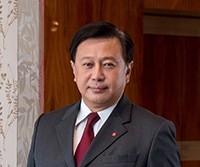Private-banking assets in East Asia will soon outpace Europe, but competition is fierce. Effective digitization holds the key to success.

Not long ago, when private bankers got together, the mood was likely to be somber. In the wake of the 2008 global financial crash and subsequent media revelations related to offshore money, the public showed increasing suspicion of private wealth. Private banking seemed doomed to struggle to retain the “private” in the face of regulatory demands, while nimbler competitors threatened to eat into whatever business regulators left standing.
Yet when you talk today to leading private bankers in Singapore—a stable haven attracting high-net-worth individuals (HNWIs) in unprecedented numbers—such anxieties seem very far away.
“Growth, increasing transparency and the sheer number of opportunities here mean that traditional clients from the US and Europe are looking to Asia to get decent returns,” says Mark Leahy, head of Fixed Income at the Singapore Exchange and former Asian regional head of Fixed Income at UBS. “Prior concerns about compliance and regulatory effectiveness have largely disappeared; we have new clients from all over looking for a safe pair of hands.”
Asia, especially, is witnessing a major expansion in private banking, says Sim S. Lim, group head of Wealth Management and Consumer Banking at DBS Bank. Private-banking assets in Asia (not including Japan) amount to $21 trillion today according to DBS, and are expected to double by 2025, for the first time making the Asian market larger than the well-established European asset pool.

“It’s exciting times for the industry, most especially here,” Lim says. “Taking China as an example, two billionaires are made every week.” Lim is confident that wealth creation in Asia will outpace both Europe and the Americas in the foreseeable future. Largely entrepreneurial, centered in disruptive industries like fintech and pharma tech, and located in such markets as Indonesia, Malaysia and Thailand, a generation of HNWIs have grown up with starkly different characteristics, preferences and needs than their predecessors.
“Whereas wealth used to be accumulated over long periods of time, now it is being created much faster,” says Lim. “This creates not just an opportunity for banks to engage entrepreneurial HNWIs on their rapidly growing businesses, but at the same time to help manage, protect and grow their personal wealth, which has boomed rapidly in a short time.”
They manage their banking relationships differently, too. “Interestingly for DBS, unlike previous generations who tended to engage multiple banks, we’ve observed that the newer generation of HNWIs prefer to consolidate their assets with one bank,” says Lim. They are looking for “a trusted wealth management partner that is able to provide them with an integrated and bespoke offering spanning investment banking, corporate banking and wealth planning.”
That puts pressure on private banks to adapt and survive—and digitization will be a vital tool in that struggle. “Private banks have spent recent years honing their digital strategy, but 2019 appears to be crunch time,” one industry observer said recently.
“Private banking remains very analog, especially at the transaction level,” says Leahy. “It’s still common for a relationship manager [RM] to talk to a client on the phone to discuss and execute a simple listed equity transaction. The rest of the institutional world has moved on and benefited hugely from digitization. This presents a great opportunity for tech-savvy players to grow much faster than their competitors.”
Digitization can boost RMs’ efficiency, so they can deliver greater value-add to clients. But client needs will continue to evolve. The onus is on private banks to ensure their long-term relevance by enhancing their offerings and experience. In this, digitization will play a key role.
Lim cites DBS iWealth, an integrated wealth management platform launched in 2017 that allows clients to get the latest view of their portfolio, execute equity trades, fund purchases and more at any time of day online. This do-it-yourself approach gives clients more insight and control over their portfolio, “driving deeper engagement and conversations with their RMs.”
Private banks are also spending considerable intellectual bandwidth arguing the case for artificial intelligence in finance, as an elegant way to offer clients additional business and transaction tools. AI, however, requires banks to have a high level of digital savvy as well as the appropriate offerings to appeal to clients. “This year, AI will break through in many areas of banking,” Leahy argues. “Expect technologies such as AI, blockchain and Big Data to significantly impact the end-to-end wealth management experience.”
Automation can enable private banks to simplify the onboarding process and settlement of products like bonds, now only available offline, Leahy says, while AI yields data-driven insights that enable banks to offer their clients personalized, algorithm-driven financial advice. Firms can further boost efficiency, he argues, by automating parts of the know-your-client, sales surveillance and monitoring processes, and by decreasing customer onboarding times—a critical improvement as regulatory requirements and compliance costs increase across the industry.
“An example of how DBS is using AI is through our partnership with Kasisto, an AI-driven chatbot company from the US,” says Lim. Kasisto’s conversational AI platform, KAI, available on DBS iWealth, powers smart bots and virtual assistants with deep banking knowledge. “Our customers can converse directly with them, which enables deeper customer engagement.”

Environmental, social and governance (ESG) standards are another tidal wave about to hit private bankers. “No asset manager can avoid the issue,” says Leahy, “particularly now that large institutional investors are making [ESG] demands.” By extension, he argues, sustainable or impact investing will become increasingly important in the wealth management space.
Industry insiders relate this, in part, to the preferences of millennial or next-gen wealth clients, who share very different perspectives than previous generations. “Having grown up in the digital age, millennials expect banks to engage with them on the platforms they’re already on,” says Lim. “They are also more socially aware and appreciate a banking partner that aligns with their values, advocates responsible banking and helps them to give back to society in a sustainable and impactful way.”
Family offices are actively managing these aspects of their portfolios and looking for service providers that can offer these products and that operate with a strong ESG framework. “Family offices have long been an important part of the sustainable ecosystem through their philanthropic arms,” says Olivier Destandau, partner and CIO at Eightstone, a Singapore-based multi-family office. “These days, impact investing is the big focus—investing in businesses and projects that have a positive impact on social or sustainability outcomes.”
For private bankers able to integrate them into their investment strategy, ESG criteria present opportunities to create positive societal or environment impacts while beefing up financial returns, Lim says. But integrating ESG into wealth management requires significant changes across products, investment-selection methodologies and, most importantly, client mindset. DBS, for example, runs client engagement and education programs to raise awareness of the benefits of ESG.
“There is simply no point in providing a whole array of ESG products if clients don’t understand how these add tangible value to their portfolios,” Lim says. Private bankers appear determined to make the effort, however—mainly, because they have to.
“Asia is the future of wealth management,” Leahy says. “What’s attractive about Asia, in addition to size and growth rate, is the lack of established relationships compared with developed markets.” Private-banking relationships in Asia can often be counted in years, he says, whereas in Europe and North America, relationships lasting generations aren’t uncommon.
“Put all this together,” he says, “and you get a dynamic, fast-growing marketplace with relatively open competitive dynamics and a real hunger for technology.” That’s nothing to feel somber about.



